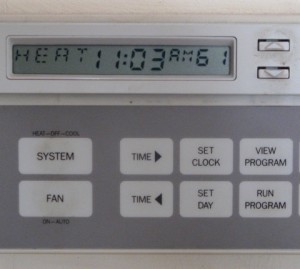My family is keeping our thermostat at 61 degrees this winter. We decided to bring it down from our traditional 65 degrees in order to save energy. [Note: Late at night at my house, the temperature automatically drops down to 55]. I’ve put a thermometer in various rooms to check the accuracy of the thermostat. The actual daytime temperature ranges from 59 to 62 in the various rooms. When we are all gone for the day, we manually set the temperature down to 55.
61 Degrees Challenge: Unlocking Comfort at Home
When I mention “61 degrees” to people, most of them are surprised; some of them are aghast. Apparently, at least among Americans, 61 degrees is an usually “cold” temperature for the interior of a house in the winter. Over the past couple of weeks, I even heard from several people who keep their thermostats above 70. When you browse the Internet, you will find numerous “authorities” advising you to set the thermostat down to 65 to save energy (e.g., here). Here’s an informal survey of quite a few folks.
Apparently, even our new energy-conscious President likes it toasty indoors. FOX News had this to say:
Obama could take a lesson from one of his predecessors, critics say.
During the gasoline shortage of the 1970s, President Jimmy Carter famously donned a cardigan and turned down the thermostat in the White House. He urged the nation to do the same during a notably chilly fireside chat he gave from his cooled-off home — a symbolic gesture intended to move other Americans to go easy on the country’s depleted stores of energy.
I understand that Obama has a lot to deal with, but I agree with FOX (for once) that he could bring the issue of energy savings to the fore by conserving it in a conspicuous way at the White House. In American, though, people don’t like being told how to live their lives, even when it’s for the good of themselves and their community in the long run. Rocky Mountain Institute’s Michael Potts had this to say:
Americans, famously independent, hate being told what to do. So there is, at times, a polarizing effect of two opposing camps: “greenies” installing double-flush toilets, and defiant “skeptics” driving Hummers.
Now back to my house: my a “cold” 61 degree house. It has been interesting to hear the reaction of several people who yesterday spoke of the “heat wave” approaching St. Louis. “By the weekend, it will be all the way up to 60 degrees! We’ll go outside and have a great time.”
My question for the day: If 60 degrees is warm for outside, why is it not warm for the inside of a house?
I was provoked to write this due to my discovery that 61 degrees is actually comfortable. Yes, it’s cooler, but putting on an extra layer of clothes solves the problem for a good cause. My conclusion is that 61 “cold” degrees inside feels an awful lot like 60 “warm” degrees outside.



When I was a toddler, my great aunt lived next door and would often take care of me when my parents had to work. When the temperature outside went below 68 degrees, she would crank up the thermostat to 90 and complain about it being cold. In the spring, when the temp outside went above 75, she would run the airconditioner a full blast, chilling the place down to 60 and complain about the heat.
The comfortable temperature is largely determined by psychological factors. and if you are accustomed to a cooler temp it seems okay. I have noticed that I sleep better if the thermostat is turned down at night.
We keep our thermostat between 64-68 in the winter.
I too have always thought it was curious how we had different standards for "warm" outside temperatures and "cold" inside temperatures.
I think it has to do with relative temperatures and expectations. I always notice how toasty 65 feels coming in out of 10 degrees.
I also notice that I am more lethargic and lazy when I feel cold (like a cold-blooded animal I suppose), it makes finding the motivation to get out bed much more difficult.
I think it makes sense that we view outside and inside temperatures on different terms. We engage in more active behaviors outside- walking, running, mowing the lawn, swimming in a pool, and a cooler temperature feels more acceptable while in motion. Inside, we spend a great deal of time sitting or laying. Of course we have different expectations for the two realms!
Plus, the bulky clothing that we readily wear outside simply does not work well in an idle setting. I can walk with a big jacket and a puffy scarf, but the limited range of motion becomes much more apparent if I try to write a paper in full winter garb, or cook dinner while wearing mittens.
However, I agree that many people take their preference to a wasteful extreme. I work in an office that regularly reaches temperatures of 75-80 degrees in the winter. I have to dress for cool weather to walk to work, but then have to strip down into something like summer attire. And in the summer, malls and movie theaters are chilled to absolute frigidness. Our attempts to over-regulate temperature waste tons of energy.